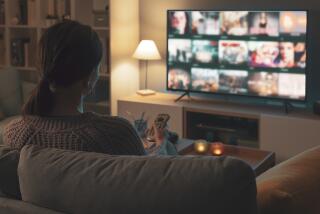Fat is the villain here in ‘Obeez City’
- Share via
To fight a war, one must dress appropriately. And sometimes, camouflage simply won’t do. That is the case for Soolynn, the sexy heroine of a new interactive DVD, “Escape From Obeez City.”
As Soolynn combats the evil forces that are making people fat, she is armed with only a few weapons -- a cat suit, an impressive bust line and an uncanny resemblance to Angelina Jolie in the movie “Tomb Raider.”
It’s a good thing she’s prepared -- cholesterol, stress hormones and free radicals reign in this electronic metropolis, located deep inside an obese man. But what happens when Soolynn is captured? For the story to unfold, kids must periodically answer educational questions.
The game’s creators hope the game-like format will provide an appealing way for children to learn about the dangers of poor nutrition and inactivity, and motivate them to change their behavior.
“In America, one in three is obese,” says Tony Findlay, project director for Big Red Frog, the Sydney, Australia-based company that is releasing the $49 game-movie in September. “We need to do something and we need to do something fast. This is our first stage of attack.”
The attack on inactivity is not just coming from the makers of “Escape From Obeez City.” It is among a handful of interactive games that aims to rouse kids onto their feet and transform living rooms into exercise zones. After all, 16% of adolescents are overweight, according to the Centers for Disease Control and Prevention. That’s an estimated threefold increase since the 1970s.
To be sure, not everyone thinks that video games -- often maligned as a key cause of kids’ inactivity -- are the optimal antidote to children’s weight problems. But the new games may signal the start of a shift in attitude.
Last fall, a report on obesity by the prestigious Institute of Medicine recommended that software engineers and game designers use those mediums as a vehicle for encouraging healthier lifestyles. And the National Institutes of Health is funding some video game research projects as part of its anti-obesity efforts.
Game companies, which like to cite the success of Konami’s popular Dance Dance Revolution as both a fun game and calorie burner, insist that the marriage of fitness and entertainment may be part of the answer.
“I see this as the first wave of something that will get much more sophisticated over time,” says Marc Prensky, a game designer who created the website www.socialimpactgames.com, which chronicles the latest health and wellness programs.
In these alternate worlds, cancer patients can battle and kill mutated cells, drivers afraid of the road can try to overcome their fears through virtual reality, and people can learn to meditate with Dr. Deepak Chopra, the author and spiritual guru.
Chopra makes a cameo appearance in “The Journey to Wild Divine: Wisdom Quest,” which transports players to a lush sanctuary where they can slow down their mind and body. Breathing must be appropriately controlled to progress to the next level, and there’s no cheating since biofeedback finger sensors monitor this. “Wisdom Quest” is a sequel CD-ROM to last year’s “The Passage,” and is developed by the Wild Divine Project, a company based in Boulder, Colo. The $49.95 “inner-active” computer program is scheduled to debut in September.
Though this may help people unwind, developers say the medium holds the most promise for trimming waistlines.
At the recent E3 gaming industry convention in Los Angeles, Sony Computer Entertainment America previewed a new fitness game in which two well-toned, virtual personal trainers guide teens through workouts in a 12-week training session. The game, EyeToy: Kinetic, is also scheduled for release in September for PlayStation 2 systems.
Instead of doing the same lunges and squats along with a videotape, Kinetic and another game, Yourself!Fitness, offer a menu full of different workouts and environments. Will today’s routine consist of downward dog in an outdoor garden or cardio on a rooftop? Players decide.
Yourself!Fitness was released last October for a slightly older audience by ResponDesign Inc., of Portland, Ore., and sells for $34.99. In this game for Xbox, PlayStation 2 and PCs, Maya, a striking young woman, leads players through 650-plus exercises -- all with her hair barely tousled. Maya will also chide people for missing scheduled workouts, as do the virtual characters of Kinetic.
Although health-oriented games are growing, they are still just a fraction of America’s $7.3-billion gaming industry. And they are not without critics.
Doctors are worried that the games may have an unintended effect: encouraging a workout for the thumbs instead of the whole body. A March report by the Kaiser Family Foundation, a nonprofit health policy organization in Menlo Park, found that kids between the ages of 8 and 18 average six and a half hours of media time a day.
“We don’t want people to sit around and be sucked into these kinds of things” at the expense of more vigorous physical activity, says Janet Fulton, an epidemiologist with the CDC’s division of nutrition and physical activity.
Video-game researchers acknowledge these concerns, but believe the potential outweighs the risk. Michael Goran, a professor of preventive medicine at USC’s Keck School of Medicine, and colleagues have created a CD-ROM dubbed “Project IMPACT.” In this electronic world, kids face another evil character who detests active children. The university is in talks with an educational software company to distribute the game to schools across the country.
“The media has a powerful effect on culture,” says Goran. “What if we can tap into that and change the way our culture thinks about food and physical activity and health, instead of printing pyramids on food wrappers?”
Some doctors, however, say that a video game will have little effect if children -- and their families -- don’t change their nutritional and exercise habits.
“If I had to choose between buying a child one of these active games or removing the TV from their bedroom and setting weekly TV time limits,” says Dr. Tom Robinson, associate professor of pediatrics at Stanford University, “I would strongly favor the latter.”
More to Read
The biggest entertainment stories
Get our big stories about Hollywood, film, television, music, arts, culture and more right in your inbox as soon as they publish.
You may occasionally receive promotional content from the Los Angeles Times.










